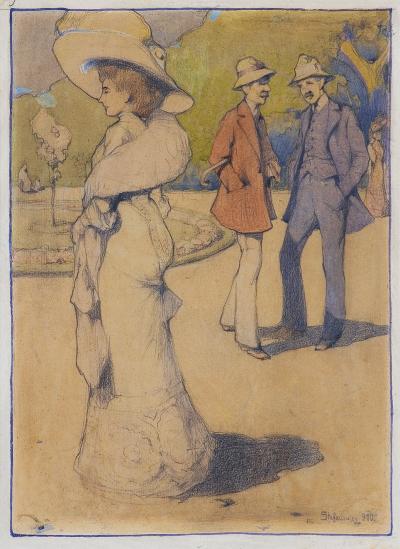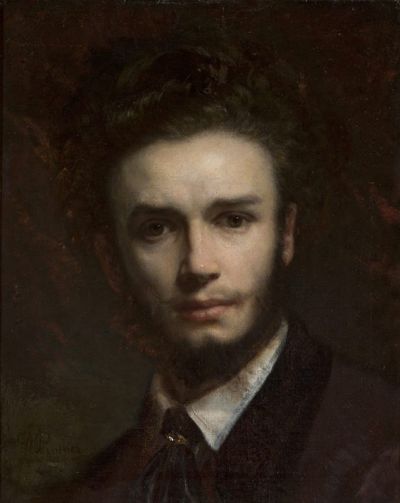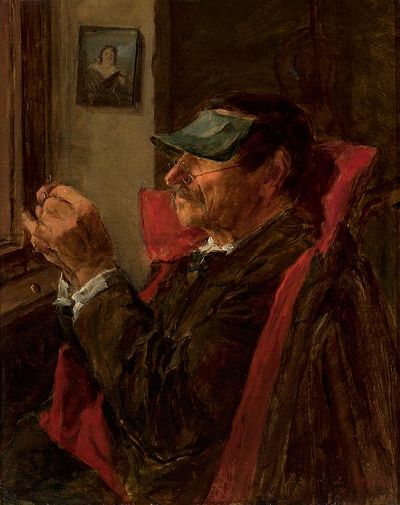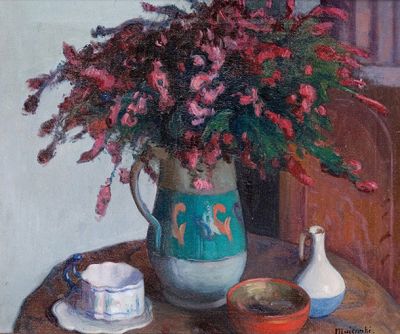Stefanowicz, Kajetan
![In the Park/W parku, Munich or Lwów 1910. Watercolour over pencil on board, 46 x 33 cm, signed bottom right: Stefanowicz [1]910, at auction (Agra Art, Warsaw 2019) In the Park/W parku, Munich or Lwów 1910. Watercolour over pencil on board, 46 x 33 cm, signed bottom right: Stefanowicz [1]910, at auction (Agra Art, Warsaw 2019)](/sites/default/files/styles/width_100_tiles/public/Stefanowicz%20Kajetan.jpg?itok=BqYT6lfQ)
Stefanowicz, Kajetan, Polish painter, graphic artist and officer, member of the "Munich School". From 1908-10, he studied at the Academy of Fine Arts, Munich. *12 July 1886 in Drohobycz, Ukraine, †29 September 1920, fell in the Polish-Soviet war in Ostróżki near Rohaczów/Rohaczów nad Słuczą (now Ostrozhok near Rohachiv-Volynska am Slutsch, Ukraine**). He was the son of the painter, professor and imperial-royal school inspector Antoni Stefanowicz (1858-1929) and his wife Maria, née Krzysztofowicz, of Armenian heritage. The family were members of the Armenian Catholic church. From 1897 to 1902, he attended school in Lwów (now Lviv) and had his first painting and drawing lesson with his father. In 1904, he took his school-leaving exams in Kolomea (now Kolomyia, Ukraine). From 1905, he studied architecture under the architect and painter Edgar Kováts (1849-1912) at the Technical University/Politechnika Lwowska in Lwów. In 1906, he switched to the Academy of Fine Arts/Akademia Sztuk Pięknych in Kraków where he studied under the late Impressionist Józef Pankiewicz (1866-1940) and the Art Nouveau painter Józef Mehoffer (1869-1946). On 13 October 1908, he joined the painting school of the genre and landscape painter Otto Seitz (1846-1912) at the Royal Academy of Fine Arts in Munich where he studied until 1910. After returning to Lwów, in 1911 he went to Paris on a scholarship and studied at the École nationale supérieure des arts décoratifs under the portrait and historical painter Ferdinand Humbert (1842-1934) who was known for his female portraits. In 1913, he returned to Lwów. In 1914, he joined the Ostlegion after responding to a mobilisation call. From February 1915, he served with the Polish Legions, from 1917 in the Austrian-Hungarian army and from 1918 in the Polish army. In November 1918, he was involved with the citizens’ militia in defending the city of Lwów which had been occupied by the Poles. In 1919, when he was a lieutenant, he took part in the capture of Vilnius during the Polish-Soviet war and, as a war correspondent, wrote articles for Polish newspapers and the weekly magazine Świat. In the same year, he and a few others founded the Polish art and literature magazine Wianki. In 1920, he was moved to the Military Ministry as training manager. In May, he took part in an expedition to Kiev, and in September he died during a military spying operation in Volhynia. He was awarded several posthumous military honours. During his time in Munich, he mainly painted landscapes, portraits and middle-class genre scenes (see cover image). Whilst his earlier portraits of females are still somewhat naturalistic, they increasingly show elegance, graceful and refined poses and gestures, and a wealth of colours in two-dimensional compositions. Influenced by late Art Nouveau, he produced decorative and symbolist compositions ("Woman with snake", watercolour, 1913), for which his wife Sabina, née Walczyńska, served as model and muse. Occasionally, his decorative compositions with a symmetrical image composition took on an ornamental style ("Angel", oil, 1911/12) (C. Rohrschneider). His closesness to the Armenian cultural circle reinforced his conviction that Polish art was influenced by the traditions of the Sarmations, Eastern cultures and oriental tendencies. During his time in Paris, he visited Musée Guimet, a museum for Asian art, where he focussed on Persian, Indian and Chinese culture and on pre-Columbian art. In his subsequent work, he combined the influences of Art Nouveau with a decorative, occasionally erotic orientalism featuring strong colour contrasts. He was also influenced by the erotic scenes of Aubrey Beardsley, which even appeared in religious scenes ("Christ and Magdalena", 1913), and by the group of illustrators connected with the Parisian satirical magazine L'Assiette au beurre. In 1912-14, he created colourful murals in the rooms of the Mortgage credit society/Towarzystwa Kredytowego Ziemskiego in Lwów (now Nationalbank), and in 1913 he also produced some for Zofia Strzałkowska’s Research Institute for Women/Zakład Naukowy Żeński. He also created pen and ink drawings, illustrations for books, magazines, posters and advertisements as well as interior designs and designs for women’s fashion. During his time serving with the Polish Legions, he drew portraits of soldiers and of the military battle and genre scenes, which he also published in legionnaires’ albums ("Pieśń Legionisty", Lwów 1916). Stefanowicz is considered an outstanding representative of the Lwów Secession/Secesja we Lwowie. His works can be found, for example, in the National Museums in Warsaw and Kraków, in the National Picture Gallery in Lviv, in the Historical Museum in Wrocław and in the museum in Elbląg. A grave of honour can be found at the Polish Cemetery of the Defenders of Lwów - Cmentarz Obrońców Lwowa in the Lytschakiwski cemetery in Lviv.
** The connection commonly made in literature and on the Internet between his place of death Rohaczów and the town of Rahatschou in Belarus is incorrect. *** Munich matriculation register, 1908
Solo exhibitions: 1913 Lwów (now Lviv), Kraków, Poznań (Tygodnik Ilustrowany, No. 44, 1913) / 1932 Lwów, Pałac Sztuki, Society of the Friends of Fine Art/Towarzystwo Przyjaciół Sztuk Pięknych we Lwowie
Group exhibitions: 1910 Lwów, Pałac Sztuki: Powszechna Wystawa Sztuki Polskiej / 1916 Kraków: Legionnaire Art / 1917 Warsaw, Society for the Promotion of Fine Arts/Towarzystwo Zachęty Sztuk Pięknych / 1924, 1934 Kraków, National Museum/Muzeum Narodowe: Exhibition of Polish Legions
Writings by Stefanowicz: O koniu, Warsaw 1920, National Library of Warsaw/Biblioteka Narodowa w Warszawie, https://polona.pl/item/o-koniu,NzMxMzIxODY/
Literature: Dmitrij Szelest/Janusz Derwojed: Lwowska Galeria Obrazòw. Malarstwo polskie, Warsaw 1990; Halina Stępień/Maria Liczbińska: Artyści polscy w środowisku monachijskim w latach 1828-1914. Materiały źródłowe, Warsaw 1994, page 24, 62; Jurij Biriulow: Secesja we Lwowie, Warsaw 1996; Wacława Milewska/Maria Zientara: Sztuka Legionów Polskich i jej twórcy 1914-1918, Kraków 1999; Polski Słownik Biograficzny, vol. 43, 2004/05; Krzysztof Stefanowicz: Rotmistrz Kajetan Stefanowicz, in: Sowiniec. Materiały historyczne i dokumenty, No. 34/35, 2009, page 81-86; C. Rohrschneider, in: De Gruyter Allgemeines Künstlerlexikon, vol. 106, Berlin/Boston 2020, page 9
Online: Matriculation database, matriculation register 3, Academy of Fine Arts, Munich, 03531 Kajetan Stefanowicz, https://matrikel.adbk.de/matrikel/mb_1884-1920/jahr_1908/matrikel-03531
More details about his artistic and military career can be found on Wiki.Ormianie, http://www.wiki.ormianie.pl/index.php/Kajetan_Stefanowicz
One work in the National Museum, Warsaw/Muzeum Narodowe w Warszawie, https://cyfrowe.mnw.art.pl/pl/katalog/523928
Works in the National Museum, Kraków/Muzeum Narodowe w Krakowie, https://zbiory.mnk.pl/pl/wyniki-wyszukiwania?phrase=Stefanowicz,%2520Kajetan
Three works in the DESA Dzieła Sztuki i Antyki auction house, Kraków, http://desa.art.pl/index.php?co=STEFANOWICZ%20Kajetan
Two works on artyzm.com, http://artyzm.com/e_artysta.php?id=382
Three works on MutualArt, https://www.mutualart.com/Artist/Kajetan-Stefanowicz/D0BCE7A974025DEE
(All links last retrieved in October 2020)
Axel Feuß, October 2020



